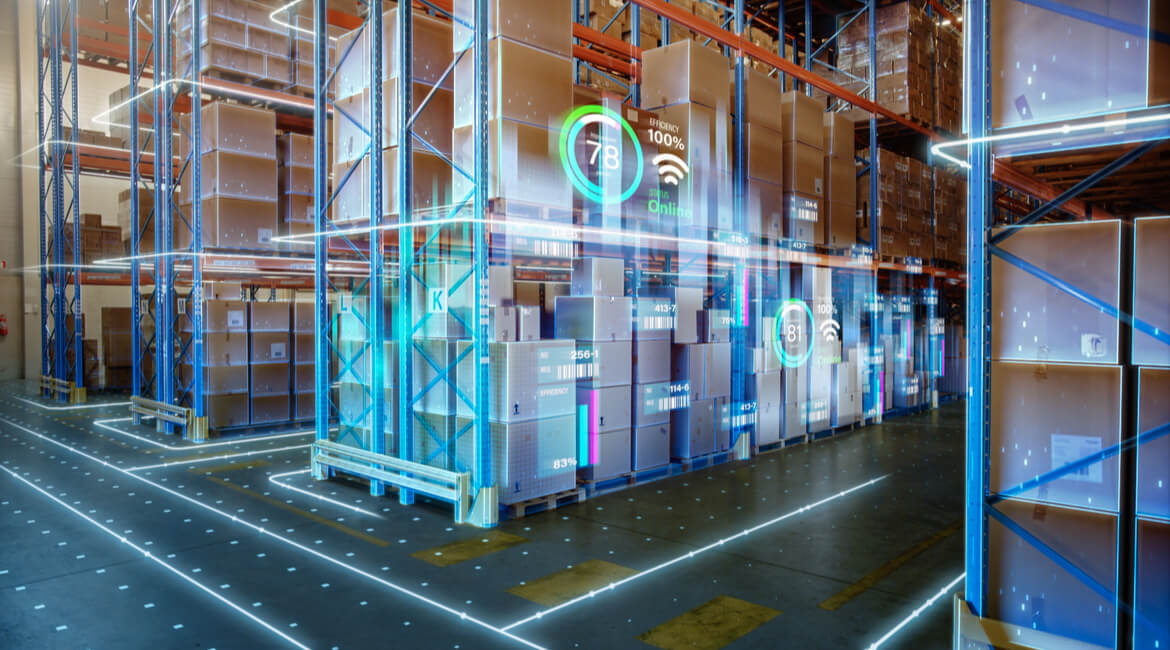Smart logistics and safety. Why IoT is needed in 5 examples

Among technological levers destined to have a disruptive – yet transformative – impact in cargo handling and warehouse logistics, the Internet of Things (IoT) plays a key role. In fact, the “Internet of connected objects” promises to make logistics even more efficient and “material handling” even safer. It is no coincidence that IoT is receiving ever-increasing interest from industry players, willing to boost investments towards this direction. Recent studies project the value of IoT for warehousing to $ 17.93 billion globally by 2025, with an expected annual growth of 21.21%.
The use of advanced sensors and IoT platforms in warehouse settings allows to connect vehicles and goods and generates data flows that, analyzed and integrated with business management applications – ERP in the first place – transform into essential strategic information, used to support decision-making processes.
Thanks to the integration with business applications and the use of technological levers such as Artificial Intelligence (AI), IoT allows to manage movements in a more dynamic way, with positive consequences in terms of lightening processes, reducing errors and management costs. It all contributes to a more efficient logistics intelligence and safety, today more critical than ever especially in high intensity environments.
It’s time to see in which contexts the Internet of Things proves to be a valuable resource in logistics, in a digital and data driven perspective.
Smart logistics: more visibility on processes and resources
A first case concerns the connection of assets. This part is typically about material handling equipment – such as forklifts or pallet trucks – that can be in communication with factory systems to ensure a superior level of control and visibility on logistics processes.
Specifically, thanks to IoT it’s possible to more accurate visibility into warehouse assets and, through the integration of specific applications such as RTLS – Real Time Locating System, it’s also possible to control positions and optionally operative statuses in real time.
The change of pace here is remarkable and produces a noticeable improvement in efficiency levels: locating systems in fact, allow to know the precise position of assets, and – based on this and other information – raise the level of logistics processes efficiency.
The result is a reduction in material handling times and a better rationalization in the use of resources. In highly automated warehouses, this and other solutions get to reduce up to 50% order picking times.
Use of resources in an optimized system
IoT applications are remarkable at all operational levels.
As part of smart manufacturing, IoT platforms are implemented throughout the production cycle: from the control of machines and facilities to the monitoring of flows up to the tracking of material and products handling operations at the shop floor level.
More specifically in the intralogistics sector, Intelligent Resource Management significantly improves the use of resources.
Real-time localization helps rationalize the use of resources so that they can be selected according to their availability, distances to cover or other parameters.
This way, workflows become more streamlined and cost-effective: it’s possible to avoid empty runs for forklifts, or, by contrast, road congestions and bottlenecks. Positive effects are also important in containment of operating costs related, for example, to energy consumptions of the vehicles themselves.
Operational performance with IoT
Continuing the examination of application cases, it can be emphasized, for example, how the use of technologies such as real-time locating systems determines a better use of resources. Combined with Artificial Intelligence algorithms, these systems can also make task management (much) more efficient.
Relying on artificial intelligence algorithms, in fact, current data can be used to “orchestrate” waves of activities with extreme precision. This way, task assignment takes place based on the resources’ position, the monitoring of the progress stays constant, and any changes in context are managed in real time.
The combination of IoT and AI-powered software leads to develop an efficient warehouse logistics management and a significant improvement in service levels as well.
Adaptive management: the secret to logistics efficiency
A true plus provided by IoT is the ability to act independently, self-regulating and reacting to context’s changes. This is also the case of IoT applications in logistics processes. Here, the real-time localization of resources, combined with Machine Learning, AI, and analytics, allows to anticipate the operations development and solve any critical issues in the bud.
In essence, thanks to IoT it’s possible to correct material handling operations during work in response to changes including any mismatches or changes in priorities.
Systems of this type are, then, much more dynamic, and operate as players of a chess game, anticipating the opponent’s moves.
IoT for greater safety
As noted in previous paragraphs, connecting assets to AI to manage activities leads to a decisive improvement in single operations and a general efficiency in warehouse material handling.
The Internet of Things, ultimately, really represents a lever to achieve not only greater efficiency in logistics activities, but also to create safer working environments.
Interconnection between objects and people is also useful to prevent risk conditions, which can jeopardize the physical health of workers or the integrity of goods and assets.
All this thanks to three main factors:
- less labor-intensive material handling management;
- real-time monitoring of areas and assets;
- self-regulation in presence of potential criticalities.
In IoT-based systems it’s possible, for example, to establish constraints in routes and accordingly manage the execution of tasks, reducing collision risks. In addition, through a virtual warehouse model, it is possible to better monitor the storage conditions of the goods. Finally, specific IoT-based applications can prevent risky situations for workers, managing access to specific areas or verifying compliance with safety measures.
